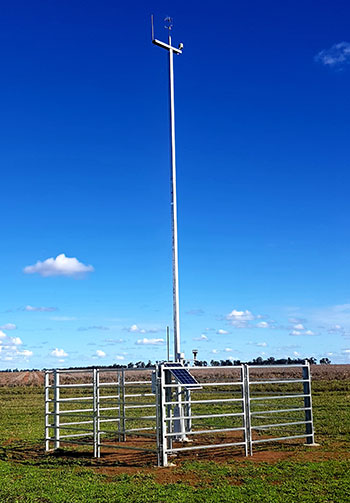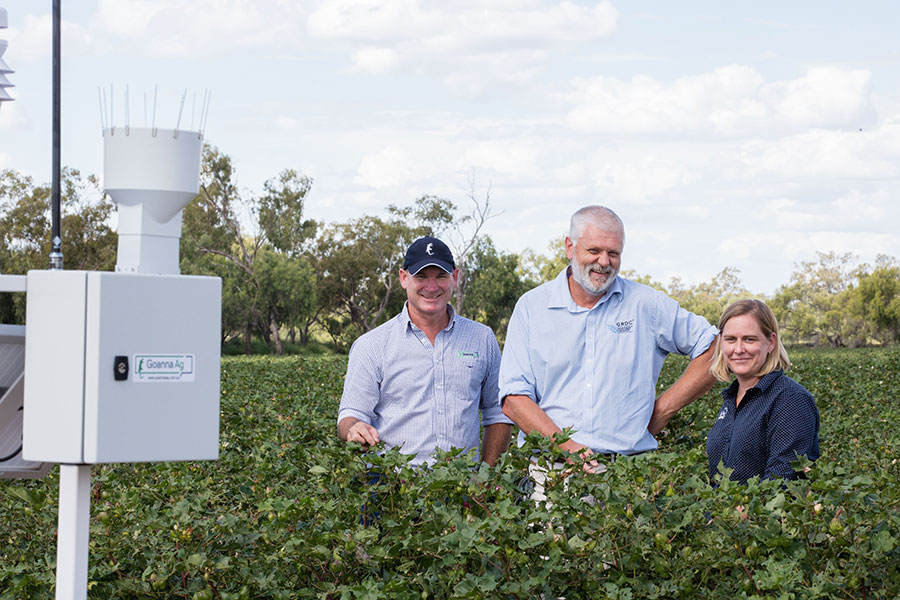When it comes to spraying, many growers are caught between a rock and a hard place.
Night-time spraying avoids hot and dry conditions, yet it can be hard to avoid inversions, which exist most nights.
This conundrum is being addressed via the $5.5 million investment being made by GRDC, the Cotton Research and Development Corporation (CRDC) and Goanna Ag to develop a spray drift hazardous weather warning system across Queensland and NSW.
The five-year investment will see a network of 100 10-metre-high weather and networked data (WAND) stations established before the summer of 2022-23. This will ensure real-time weather data can be provided to growers and spray operators about the presence of hazardous temperature inversions.
The weather stations have remote sensing capability and new proprietary software. Via an app, growers and spray contractors will be provided with real-time weather data updated every 10 minutes to identify and measure the presence of hazardous temperature inversions (see breakout).
The system
The spray drift hazardous weather warning system takes the guesswork out of spraying, leading to economic, environmental and social benefits, says researcher Dr Graeme Tepper from Micro Meteorological Research and Educational Services.
Dr Tepper and his colleague Dr Warwick Grace are responsible for the breakthrough research that helped created the system, via GRDC and CRDC support.
 One of the weather and networked data (WAND) stations. It forms part of the network of 100 10-metre-high stations. Photo: GoannaAg
One of the weather and networked data (WAND) stations. It forms part of the network of 100 10-metre-high stations. Photo: GoannaAg
Dr Tepper says the difficulty faced in making spraying decisions comes down to two important variables – whether an inversion exists and if that inversion is hazardous.
“Inversions exist most nights from dusk to an hour after sunrise. But to know if an inversion is hazardous requires firstly that we know that an inversion is present and secondly the wind flow conditions and the level of turbulence within the inversion.
“Some inversion conditions are not hazardous while others are very hazardous. Guesswork is mostly used to determine if inversions exist, but the cues used may not appear at all or only appear well after an inversion has set in.
“Ultimately, guesswork will lead to some believing that they’re okay to spray when in fact conditions are the most hazardous.”
The spray system overcomes this by determining whether the wind flow is laminar, meaning it flows in a smooth, straight line and is therefore hazardous. Dr Tepper says that when wind flow lacks turbulence and becomes laminar, spray drift can be transported long distances close to the surface at high concentrations. “This drift can spread out like a fan or accumulate into lower-lying regions before contacting surfaces.”
If instead there is a sufficiently high level of atmospheric turbulence, spraying can take place.
“By having this information at hand, growers and spray operators will be well-placed to avoid hazardous inversions and find that there are more hours open to spraying at night than first thought.”
Benefits
GRDC chemical regulation manager Gordon Cumming says that until now it has not been possible for spray applicators to accurately measure the presence of hazardous inversion conditions.
“Currently, applicators must rely on basic clues and judgement to support a ‘best’ guess.
“Now an objective – rather than a subjective – decision on hazardous spray conditions can be made. It gives staff without skills a definitive ‘stop/start’ for spraying.”
This has benefits for growers and other agricultural producers in several ways.
“Pesticides are an important component of modern farming and play a major role in maintaining high productivity. Yet, unintended herbicide damage is an issue. When spray droplets are captured and transported in thermal temperature inversions, these compounds can affect agricultural enterprises in other areas, severely damaging or killing sensitive vegetation,” Mr Cumming says.

GoannaAg chief operating officer Tom Dowling with GRDC manager of chemical regulation Gordon Cumming and Susan Maas, CRDC’s research and development manager at the announcement of the $5.5 million investment to develop a spray drift hazardous weather warning system across Queensland and NSW. Photo: Mel Jensen
The off-target movement of both herbicides and pesticides is a particularly acute problem in mixed-cropping regions where a diverse range of chemicals may be applied at any given time.
Research has found that spraying conditions can result not only in unintended damage to non-target crops, but up to 50 per cent of applied pesticide might be lost to the environment in some circumstances, he says.
Other benefits include avoiding yield loss across industry; increasing chemical efficacy; improving labour and machinery productivity; and minimising environmental damage to non-farming ecosystems.
More information: Gordon Cumming, 0428 637 642, gordon.cumming@grdc.com.au
Beta testers needed
With a beta version of the app being rolled out in September 2022, Goanna Ag is looking for interested growers in Queensland and NSW to become involved. Goanna Ag chief executive officer Alicia Garden says the app’s beta version will allow growers to test the spray drift hazardous weather warning system before it is officially released in November. This will not only provide feedback to developers, but also give growers the chance to see how the system fits in with their operation.
The app brings together the information needed to make informed spraying decisions, relying on the weather and networked data (WAND) stations being built. The weather stations provide real-time weather data and alerts about the presence of temperature inversions. The app updates this data every 10 minutes.
From Emerald in Central Queensland to the Victorian border, the network of 100, 10-metre-high stations is being built and on track to be completed in November.
Interested growers can visit Goanna Ag's Spray Inversion Network to express interest in using the system.
More information: Alicia Garden, 0438 877 759, agarden@goannaag.com.au, Goanna Ag website.

























































